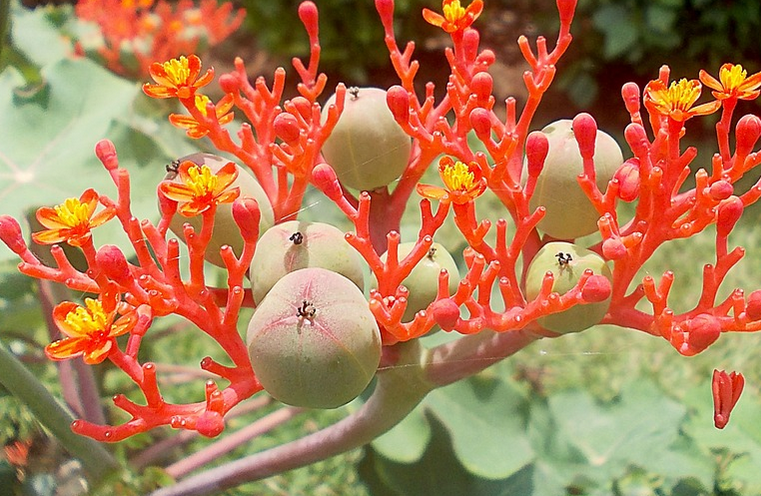Growth and production of physic nut (Jatropha curcas L.) under phosphorus levels applied to the base.
DOI:
https://doi.org/10.20873/jbb.uft.cemaf.v4n3.saraivaKeywords:
biodiesel, oilseed, fertilization, renewable fuelAbstract
This study aimed to evaluate the influence of phosphorus on the growth and yield of physic nut (Jatropha curcas L.). Physic nut seedlings, two months old were transplanted in February 2007. In June 2008 it was held in drastic pruning all plants in height of 80 cm of soil. The treatments consisted of P2O5 doses: 0, 50, 100, 150 and 200 g-1 pit. The experimental design was a randomized block with four replications of eight plants, totaling 40 plants per block. The evaluation period of the experiment it was realized between October 2008 to October 2009 (corresponding to the 2nd year of assessment), and between October 2009 and October 2010 (corresponding to the 3rd year of assessment), and the evaluated variables: the number of branches prior to pruning, the number of branches after pruning, the number of branches in inflorescence, number of inflorescences plant 1, the number of branches with clusters, the number of clusters plant-1 and productivity. Pruning stimulated the growth and production of physic nut. The increase in phosphorus fertilization increased the productivity of physic nut, reaching a stable starting dose of 150 g ha-1 of P2O5. The cultivation of physic nut can be considered a species that responds to fertilization.
References
ARRUDA, F.P.; BELTRÃO, N.E.M.; ANDRADE, A.P.; PEREIRA, W.E.; SEVERINO, L.S. Cultivo de pinhão-manso (Jatropha curcas L.) como alternativa para o Semi-Árido nordestino. Revista Brasileira de Oleaginosas e Fibrosas, v.8, p.789-799, 2004.
CRAWLEY M.J. (2007) The R Book. John Wiley & Sons Ltd., Chichester, England.
DURÃES , F.O.M.; LAVIOLA , B.G.; ALVES, A.A. Potential and challenges in making physic nut (Jatropha curcas L.) a viable biofuel crop: the Brazilian perspective. CAB Reviews: Perspectives in Agriculture, Veterinary Science, Nutrition and Natural Resources, v.6, p.1‑8, 2011.
ERASMO, E.A.L.; MATA, J.F.; FIDELIS, R.R.; SANTOS, G.R.; SILVA, A.A. Desenvolvimento de plantas de pinhão-manso em resposta à adubação fosfatada (1° ano). In: I CONGRESSO BRASILEIRO DE PESQUISAS DE PINHÃO- MANSO, 2009, Brasília, DF. CD-ROM, 2009.
FERRARI, R.A.; OLIVEIRA, V.S.; SCABIO, A. Biodiesel de soja – taxa de conversão em ésteres etílicos, caracterização físico-química e consumo em gerador de energia. Quimica Nova, v. 28, n. 1, p.19- 23, 2005.
LAVIOLA, B. G.; DIAS, L. A. S.; Teor e acúmulo de nutrientes em folhas e frutos de pinhão-manso. Revista Brasileirade Ciência do Solo,v.32, n.5, p.1969-1975, 2008.
LIMA, R.L.S.; SAMPAIO, L.R.; FREIRE, M.A.O.; JÚNIOR, G.S.C.; SOFIATTI, V.; ARRIEL, N.H.C.; BELTRÃO, N.E.M. Crescimento de plantas de pinhão-manso em função da adubação orgânica e mineral. In:CONGRESSO BRASILEIRO DE MAMONA, 4& SIMPÓSIO INTERNACIONAL DE OLEAGINOSAS ENERGÉTICAS, 1, 2010, João Pessoa. Inclusão Social e Energia: Anais... Campina grande: Embrapa Algodão, 2010. p. 528-534.
LOPEZ, A. S. Solos sob “cerrado”: Características, propriedades e manejo. Piracicaba, POTAFÓS. 1984. 162p.
MARTINS, L.D.; TOMAZ, M.A.; AMARAL, J.F.T.; LAVIOLA, B.G.; BORCARTE, M. Desenvolvimento inicial de mamona e pinhão-manso em solo submetido a diferentes corretivos e doses de fósforo. Revista Verde (Mossoró-RN-Brasil) v.5, n.1, p.143-150, 2010.
PERES, J. R. R.; FREITAS, J. E.; GAZZONI, D. L. Biocombustíveis. Uma oportunidade para o agronegócio brasileiro. Revista de política agrária, 2005.
RUBEL, F.; KOTTEK, M. Observed and projected climate shifts 1901-2100 depicted by world maps of the Köppen-Geiger climate classification. Meteorol. Z., n.19, p. 135-141. 2010. DOI: 10.1127/0941- 2948/2010/0430.
R Development Core Team (2010). R: A language and environment for statistical computing. R Foundation for Statistical Computing, Vienna, Austria. ISBN 3-900051-07-0, URL. Disponível em:<http://www.R-project.org> acesso em 25/08/2010.
SATURNINO, H.M.; PACHECO, D.D.; KAKIDA, J.; TOMINAGA, N. & GONÇALVES, N.P. Cultura do pinhão-manso (Jatropha curcas L.). Informe Agropecuário,v. 26, n 229,p.44-78, 2005.
SILVA, J.T.A.; COSTA, E.L.; SILVA, I.P.; NETO, A.M. Adubação do pinhão-manso (Jatrophacurcas L.) com nitrogênio e fósforo. In: 4° CONGRESSO BRASILEIRO DE PLANTAS OLEAGINOSAS, ÓLEOS, GORDURAS E BIODIESEL, 2007. CD- ROM.
SILVA J.T.A.; PEREIRA R.D.; SILVA I.P. Avaliação do estado nutricional do pinhão-manso (JatrophacurcasL.) Adubado com nitrogênio e fósforo. In: VI CONGRESSO BRASILEIRO DE MAMONA, Energia e Sustentabilidade, 2009, Montes Claros, PB. CD-ROM, 2009.
TAIZ, L.; ZEIGER, E. Fisiologia vegetal. 3ed. Porto Alegre: Artmed, 2004.
TEIXEIRA, L. C. Potencialidades de oleaginosas para produção de biodiesel. Informe Agropecuário, Belo Horizonte, v. 26, n. 229, p. 18-27, 2005.

Published
How to Cite
Issue
Section
License
Copyright (c) 2024 - Journal of Biotechnology and Biodiversity

This work is licensed under a Creative Commons Attribution 4.0 International License.
Authors who publish with this journal agree to the following terms:
Authors retain copyright and grant the journal right of first publication with the work simultaneously licensed under a Creative Commons Attribution License (CC BY 4.0 at http://creativecommons.org/licenses/by/4.0/) that allows others to share the work with an acknowledgement of the work's authorship and initial publication in this journal.
Authors are able to enter into separate, additional contractual arrangements for the non-exclusive distribution of the journal's published version of the work (e.g., post it to an institutional repository or publish it in a book), with an acknowledgement of its initial publication in this journal.
Authors are permitted and encouraged to post their work online (e.g. in institutional repositories or on their website) prior to and during the submission process, as it can lead to productive exchanges, as well as earlier and greater citation of published work (Available at The Effect of Open Access, at http://opcit.eprints.org/oacitation-biblio.html).


